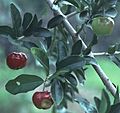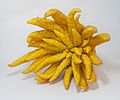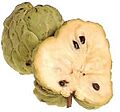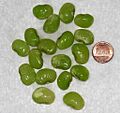List of Vietnamese ingredients facts for kids
Vietnamese cuisine is famous worldwide for its fresh ingredients and amazing flavors. From savory soups to sweet fruits, the food in Vietnam uses a wide variety of ingredients. Let's explore some of the most important and interesting ingredients you might find in a Vietnamese kitchen!
Contents
Meats and Seafood in Vietnamese Cooking
Vietnamese food uses many kinds of meat and seafood. These ingredients are often the main part of a meal, adding rich flavors and textures.
Popular Meats
- Beef (thịt bò): Beef is used in many popular dishes. One famous dish is Phở, a delicious noodle soup. Another is Bò 7 món, which means "Seven-course beef," a special meal with beef prepared in seven different ways.
- Chicken (thịt gà): Chicken is a common meat in Vietnamese cooking. It's used in soups, stir-fries, and grilled dishes.
- Pork (thịt heo): Pork is very popular and used in many everyday meals. You'll find it in spring rolls, noodle dishes, and stews.
- Fish (cá): Fish is a staple, especially in coastal areas. It's often grilled, fried, or used in soups and sauces.
- Shrimp (tôm): Shrimp are widely used, fresh or dried. They add a sweet, savory taste to many dishes, from salads to stir-fries.
Unique Meats and Seafood
- Goat meat (thịt dê): Goat meat is enjoyed in some regions, often grilled or in stews.
- Frog legs (đùi ếch): Frog legs are a delicacy in some parts of Vietnam, often fried or stir-fried.
- Snails (Ốc bươu): Snails are a popular snack or appetizer. They are often stuffed with pork or steamed and served with a tangy rice vinegar sauce.
- Ragworms (rươi): These special worms are found in Hanoi. They are used to make unique dishes like fried omelets called chả rươi or a fermented sauce called mắm rươi.
Grains and Legumes: Building Blocks of Meals
Grains and legumes are very important in Vietnamese cooking. They provide energy and are used in many different ways, from main dishes to desserts.
Grains
- Glutinous rice (gạo nếp): This sticky rice is a key ingredient. It's used to make sweet desserts, savory snacks, and special dishes like Xôi gấc, which is sticky rice colored red with gac fruit.
- Wheat gluten (mì căng or mì căn): This is often used as a meat substitute, especially in vegetarian dishes.
Legumes
- Mung bean (đậu xanh): Mung beans are very versatile. They are used in both sweet and savory dishes, like desserts, soups, and fillings for pastries.
- Black-eyed pea (đậu trắng): These beans are used in various dishes, often in soups or sweet desserts.
- Hyacinth bean (đậu ván): Another type of bean used in Vietnamese cooking.
- Winged bean (đậu rồng): These beans have a unique shape and are often eaten raw in salads or lightly cooked.
Fresh Vegetables: Adding Color and Crunch
Vietnamese cuisine is known for its fresh vegetables. They add flavor, texture, and important nutrients to every meal.
- Bitter melon (Khổ qua): This vegetable has a unique bitter taste. It's often used in soups like Canh Khổ Qua or stir-fries.
- Carrot (Cà rốt): Carrots add sweetness and color to many dishes, including salads and stir-fries.
- Chili pepper (ớt): Chilies are used to add heat and spice to dishes. They can be fresh, dried, or made into sauces.
- Cucumber (dưa leo): Cucumbers are often served fresh with meals or used in salads for a refreshing crunch.
- Eggplant (cà tím): Eggplant is cooked in many ways, including stir-fries and stews.
- Water spinach (rau muống): This leafy green vegetable is very common. It's often stir-fried with garlic or added to soups.
- White radish (củ cải trắng): Radishes are used in soups, pickles, and sometimes eaten raw.
- Water chestnut (củ năng): These crunchy vegetables are often added to stir-fries or desserts.
- Welsh onion (hành): Also known as scallions, these are used for flavor and garnish. A popular topping is mỡ hành, which is chopped scallions with hot oil poured over them.
Fragrant Spices and Herbs
Herbs and spices are essential to Vietnamese cuisine. They give dishes their distinct aromas and flavors.
- Lemon grass (sả): Lemon grass has a fresh, citrusy scent and is used in many soups, curries, and marinades.
- Long coriander (ngò gai): Also called saw tooth coriander, this herb has a strong, unique flavor and is often added to soups like Phở.
- Thai basil (rau quế): This herb has a sweet, peppery, and slightly anise-like flavor. It's often served fresh with noodle soups and curries.
- Turmeric (nghệ): Turmeric gives a beautiful yellow color and earthy flavor to many dishes, especially curries and stir-fries.
- Vietnamese coriander (rau răm): This herb has a peppery taste and is often used in salads and some savory dishes.
- Dill (thì là): Dill is used in specific dishes like chả cá, a famous grilled fish dish.
- Vietnamese Balm (kinh giới): This herb is typically eaten raw with grilled meats and other cooked foods.
- Fishy-smell herb (giấp cá): This herb has a unique, slightly fishy smell and is often eaten raw with various dishes.
Delicious Fruits: Sweet and Tangy Treats
Vietnam has a wide variety of tropical fruits, enjoyed fresh or used in desserts and drinks.
- Dragon fruit (thanh long): This fruit has a bright pink or yellow skin and white or red flesh with tiny black seeds. It's sweet and refreshing.
- Durian (sầu riêng): Known for its strong smell, durian is a popular fruit with a creamy, sweet flesh.
- Jackfruit (mít): Jackfruit can be eaten ripe and sweet, or unripe as a vegetable in savory dishes. You can also find it as crispy chips called Mít sấy.
- Mango (xoài): Mangoes are sweet and juicy, enjoyed fresh or in salads and desserts.
- Mangosteen (măng cụt): This fruit has a dark purple rind and sweet, juicy white segments inside.
- Papaya (đu đủ): Papaya is a sweet, soft fruit, often eaten ripe or used unripe in salads.
- Pomelo (bưởi): A large citrus fruit, similar to a grapefruit but sweeter and less bitter.
- Rambutan (chôm chôm): This fruit has a hairy red skin and sweet, translucent flesh, similar to lychee.
- Sapodilla (hồng xiêm): A sweet, brown fruit with a grainy texture, often eaten ripe.
- Star fruit (khế): This fruit has a unique star shape when sliced. It can be sweet or tart.
- Sugar-apple (na or mãng cầu): This fruit has a bumpy skin and sweet, creamy flesh.
- Watermelon (dưa hấu): A refreshing and sweet fruit, especially popular in hot weather.
Images for kids
See also



























































